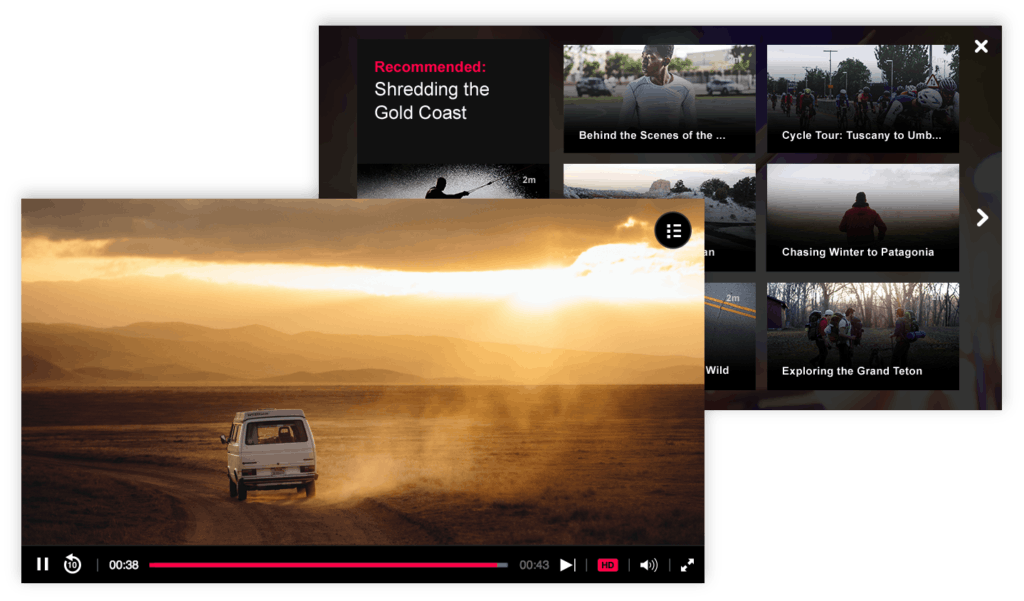There’s no better way for publishers, broadcasters, and media companies to maximize their revenue streams than to monetize their video content.
We all know how crucial video content has become to publishers’ growth strategies, with consumers watching and demanding more videos than ever before. In fact, a global consumer survey shows that respondents watched an average of 19 hours of online video content weekly in 2022. Moreover, Cisco predicted that internet video traffic would account for 82% of all consumer internet traffic by the end of 2022.
It’s understandable that you’d want to seize the opportunity to share videos that will help you connect with your audience on a much deeper level and create a stable revenue stream at the same time.
So, let’s talk about what video monetization is and the most common models, and then compare the best video monetization platforms for an elevated digital marketing strategy.
What is video monetization?
Video monetization is the process of earning money through videos you publish online on any platform. Getting paid for sharing live videos or videos on demand (VOD) can be achieved through advertising, subscriptions or direct transactions.
The easiest approach to video monetization would be to upload content to your YouTube channel and take advantage of its video ads capabilities. However, unless your video is watched millions of times, you’re unlikely to earn any decent ad revenue from YouTube monetization.
Furthermore, if you’re a business that sustains itself on driving viewers to your video content, solely relying on YouTube just isn’t a feasible option for scalability.
Luckily, your YouTube channel is only one of many monetization platforms out there. So, which one should you pick? Let’s explore in more detail how your video content can earn you money.
What is a video paywall?
A video paywall acts as a digital barrier to video content that can only be accessed by the user if they submit a payment, either on a subscription or pay-per-view basis. Content creators and publishers install paywalls to generate revenue and monetize their video content.
Video paywalls are commonly used by online streaming platforms, news organizations, educational websites, or other content providers to monetize their video content. They can take different forms:
- Subscription-based paywall: Viewers pay a recurring fee (monthly or annually) to access a library of videos. Popular examples include Netflix, Disney+, or HBO Max.
- Rental or PPV (pay-per-view) paywall: Users pay a one-time fee to watch a specific video or a limited-access to a set of videos. This model is often used for movies, special events, or premium content.
- Freemium paywall: Basic content is available for free, but premium or exclusive videos are locked behind a paywall. This model encourages users to subscribe for enhanced access.
- Metered paywall: Users are allowed to watch a certain number of videos for free within a specific time period, after which they are prompted to subscribe or pay for additional access.
- Hybrid paywall: Combines elements of different paywall models, offering a mix of free and paid content to cater to a wide audience.
How JWP uses InPlayer’s paywall solution
With the integration of InPlayer, JWP has augmented its capabilities by blending its exceptional subscription management, payment processing, and identity management functionalities with industry-leading advertising features. Following the acquisition, JWP has unlocked a range of enhanced capabilities:
- Flexible subscriptions and payment models: JWP allows content providers to choose from tailored subscription models catering to specific viewer requirements. This includes personalized subscription tiers and packages, such as AVOD, TVOD, SVOD, seasonal access, coupons, and vouchers,
- Global market expansion: JWP understands the diversity of global payment preferences and offers a localized approach so that you can generate revenue anywhere. This includes support for multi-language interfaces, multi-currency transactions, and geo-pricing. Our platform integrates Single-Sign-On (SSO) options with OAuth, social media platforms, and offers premium in-app purchases.
- Tailored brand experiences: Delivering captivating brand experiences is effortless with JWP’s customizable solutions. Creators can opt for either a white-label, fully customizable theme or a pre-built paywall preview that aligns with their webpage’s aesthetics.
- Identity management: Gain end-to-end control of the subscriber lifecycle, overseeing subscription operations, designing optimal customer journeys, customizing registration fields for actionable data, and nurturing customer relationships through newsletter opt-ins.
- User transaction tracking: With JWP, tracking individual user transactions and managing accounts becomes seamless. Security measures and access restrictions can be applied based on login sessions, domains, age, and location.
- Data compliance and security: JWP adheres to leading data protection regulations such as PCI DSS, GDPR, and CCPA. Our commitment to data security underscores our platform’s dedication to safeguarding private user information.
How to monetize a video
There’s tons of ways in which broadcasters and video creators can monetize their video content, however, the most common ones fall into three categories: AVOD, SVOD, and TVOD. There is also a hybrid video monetization strategy combining SVOD with TVOD.
Choosing the right video monetization method for you is crucial as it will have short-term and long-term implications for your brand and revenue potential. But there’s no simple answer which one is better than the other.
We’ll cover the pros and cons of each to help you make an informed decision and let your business grow.
AVOD
Advertising video on demand (AVOD) is a video monetization model which allows you to generate revenue through ads that are shown before and during videos. It very much resembles the traditional TV broadcast model where your favorite program is ‘interrupted’ by short commercial breaks.
As a content creator, you might find this sponsorship model appealing as it allows you to target a specific demographic and narrow down your audience based on certain behavioral traits. Advertising video on demand offers a low-risk way to monetize your content, is easy to set up and has a low barrier to entry.
A good example of an AVOD platform is YouTube. But as mentioned before, how much you earn will depend on the amount of times your video ad gets watched. The pricing for your ad placement will also depend on your audience size.
When making your decision on which video monetization model to go for, consider that online viewers expect to see ads that are tailored to their hobbies and shopping habits. In fact, 75% prefer ads that are aligned to their needs and interests.
AVOD is a strong primary strategy, but also works very well as a supplementary monetization model. If you employ AVOD, ensure your video ads are personalized to boost viewership and engagement.
SVOD
SVOD stands for subscription video on demand, often referred to as subscription VOD. This monetization model allows users to consume unlimited video content when they enter a subscription agreement and pay a small recurring monthly or annual fee.
Market giants like Netflix, Amazon Prime, Apple TV, Hulu, and Disney + have all adopted a subscription-based model. Some of these SVOD platforms are ad-free, but others include ads on lower-tier pricing packages.
With SVOD you know how much revenue to expect at the end of the month. And you get greater pricing flexibility.
On that note, if you choose the SVOD model, you’ll need to consistently provide high-quality content. This often means investing more time and money to keep your current subscribers engaged and attract new ones.
SVOD can also apply to live streaming content, for example live sporting events, webinars, and other live entertainment.
TVOD
Transactional video on demand (TVOD), also known as pay-per-view streaming, allows viewers to buy content on a limited basis. So, if you remember that time you purchased content on Google Play or iTunes, you were taking advantage of TVOD.
Instead of paying a monthly subscription, you only pay a one-time fee and get to either keep the content you want to watch, or rent it.
One of the biggest benefits of TVOD is that users maintain a high degree of control by selecting only the content they want to purchase. You can use less expensive content to your advantage by offering it as a way to entice viewers to purchase more content. Or, you can offer premium content at higher price points and decide the terms of how long they’re able to access the content.
On the flip side, the pay-per-view model means you’ll only attract people who need something from you and once they get it, they are done. This makes it more difficult to create a loyal customer base.
Hybrid: SVOD + TVOD
By now, you might have realized that many companies employ a hybrid model. Publishers might use AVOD to create awareness of their platform, switching to an SVOD model to retain customers by providing premium content.
Mixing and matching video monetization options might be the best way to unlock your revenue potential from your video content. Let’s look at Amazon Prime as an example.
Amazon Prime charges viewers a monthly or annual membership fee to access its content (SVOD), but it also gives people an option to rent or buy certain premium content like the latest cinema movie or new series (TVOD).
Combining SVOD with TVOD, and even with AVOD, can of course take more effort and time to set up and manage, but it’ll help you reach different types of viewers.
How to find the best VOD model for you?
Now that you know about the different video monetization models, you’re probably wondering which one (or ones) is the best for you. Here’s a quick checklist of the things you need to take into consideration before making a final decision:
- Your target audience – What are your viewers’ interests? How big is your audience? Do they prefer free content or paying a subscription fee? What are their viewing habits?
- Your content – Do you have premium content that your viewers would be willing to pay for? Do you have the capabilities to regularly create exclusive content to keep your audience engaged?
- Your goals – How much revenue do you want to generate? Do you prefer a more predicable income? Are you aiming to create a loyal community?
- Your platform – Do you currently have a VOD platform? Do you need an easy-to-use platform or do you have the skills and time to play around with multiple monetization features?
For example, DER SPIEGEL, a prominent German publisher, found a dynamic solution by partnering with JWP to monetize their video content using the AVOD model. Facing the surge in online news consumption in 2020, DER SPIEGEL capitalized on JWP’s live streaming capabilities to introduce exclusive live streams and news conferences. This strategic move not only enriched user experience but also fueled engagement, capturing the essence of AVOD’s potential.
By seamlessly integrating video content, DER SPIEGEL maintained their extensive reach while effectively monetizing content through advertising. JWP’s white-label solution and monetization tools empowered DER SPIEGEL to leverage video as a revenue stream, showcasing the prowess of ad monetization amidst an era of rapid digital transformation.
Who needs a video monetization platform?
Broadly speaking, content creators who want to earn money off of their content.
These could be broadcasters who have an entire VOD library they wish to monetize, or advertisers and marketers who want to drive their clients’ business growth at scale.
With online learning booming, educational institutions and e-learning providers are also increasingly taking advantage of video monetization platforms to enrich the learning experiences and increase student engagement.
Even fitness instructors and yoga lovers are turning their studios into best-in-class video experiences for members at home, earning ad revenue in the process.
So, strictly speaking, you don’t have to be a video business or a video marketing professional to need an online video platform or a streaming service.
12 best video monetization platforms for 2023
Now that you know about the benefits of video monetization and the most common models of content monetization, it’s time to look at and compare ten of the best platforms out there to help you transform your videos into money-making assets.
1. JWP

JWP is an all-in-one SaaS platform boasting 40,000 broadcasters, publishers, educators and other video-driven brands whose business relies on video as users.
JWP offers live streaming and VOD streaming capabilities, customizable 24/7 live channels and the fastest HTML5 Player on the Web to ensure you’re delivering state-of-art viewing on any device.
Through JWP, you can deploy videos quickly and easily to your iOS and android applications with mobile SDKs or over-the-top (OTT) apps solution. JWP offers outstream and instream ad capabilities so you can monetize video ads within video or without video content.
JWP works with any video ad server, network or exchange, and includes built-in support for SpotX, Google DFP, Google IMA, AdX, and FreeWheel.
In addition, JWP offers Video Player Bidding, the first solution of its kind with header bidding built directly into the player to drive monetization and reduce latency.
In terms of analytics, JWP offers comprehensive, real-time insights so you can better understand your community engagement and maximize your income.
With JWP’s video monetization solution, you get to keep 100% of your ad revenue. A recent Forrester study showed that JWP clients see a 482% ROI.
2. Uscreen
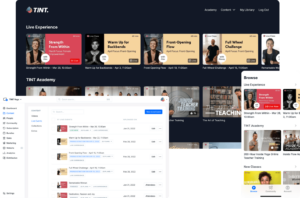
Uscreen is a monetization and OTT platform, catering for every video business need. The platform supports SVOD, TVOD and hybrid models.
They allow you to create a standalone video membership site for complete ownership of your content. You can also launch a professionally branded video streaming app for TV and mobile, with no coding knowledge required.
Uscreen enables the creation of live streaming events and offers in-depth analytics so you can track and measure your content performance in real time.
Reviews on Capterra and G2 say that Uscreen seems to be easy to navigate for some, but not as intuitive for others. Some users also say customization functionalities are limited in some areas. Its most popular Growth plan costs $159 per month and there is a $0.50 fee for each subscriber.
3. Twitch
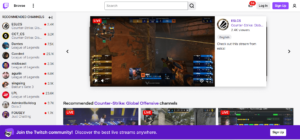
Twitch is an interactive video live streaming service for content spanning video games, entertainment, sports, music, and more. It’s free to join and offers its partners and affiliates many ways to monetize their content.
Twitch Affiliates can earn revenue from subscriptions, ads and Bits (virtual goods). To become a Twitch Affiliate, you need to meet certain criteria:
- At least 500 total minutes broadcast in the last 30 days
- At least 7 unique broadcast days in the last 30 days
- An average of 3 concurrent viewers or more over the last 30 days
- At least 50 Followers
If you’re ready to level up from an Affiliate, you can join the Twitch Partner Program. As a Twitch Partner, you can accept subscriptions from your viewers and earn a share of the revenue generated from any ads played on your channel.
Twitch also provides participating Partners a share of the revenue Twitch receives from Bits equal to 1 cent per Bit used to Cheer for them. As a Partner, you also get to customize your Cheermotes and Bit Badges.
Twitch offers the perfect alternative to YouTube. However, the enormous volume of account holders means you might have to spend tons of hours on the platform to stand out and start generating income.
4. YouTube
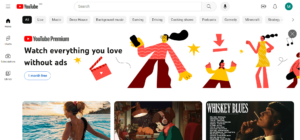
YouTube stands out as a video monetization platform offering a dynamic space for content creators to transform their passions into lucrative ventures. Through the YouTube Partner Program and Google AdSense account integration, you can harness your creativity to generate passive income from ads displayed alongside your captivating YouTube videos.
The introduction of Super Chat, stickers, and channel memberships further enables direct fan support during live interactions, strengthening the bond between you as a YouTube creator and your audience. What’s more, the addition of the Merch Shelf is a great opportunity for you to sell your merchandise directly to fans, maximizing your earning potential.
Entrepreneurs and aspiring content moguls can turn their hustle into a sustainable career by adhering to YouTube’s advertiser-friendly content guidelines and leveraging YouTube Shorts to quickly engage viewers and increase watch hours.
5. Vimeo

Vimeo is a video sharing website which offers monetization through subscriptions and pay-per-view. You can join Vimeo on a free plan if you’re not going to upload tons of videos, or upgrade to advanced or enterprise plans if you want to live stream videos or access more marketing tools.
Pricing starts to grow as your needs for extra functionalities grow, for example live streaming, broadcasting, OTT apps or a customizable video player.
Vimeo doesn’t offer many integrations or marketing tools, which is a downside for those wishing to launch strong and revenue-generating campaigns and increase video views.
6. Patreon
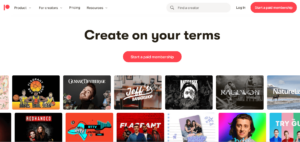
Patreon is a video monetization platform perfect for creators to generate a monthly revenue stream that’s not tied down to one video hosting platform. So, you can ask your audiences from YouTube or Discord to support you on Patreon.
Patreon lets you charge members a recurring fee, and for that, you can offer podcasts, music videos, webinars, and more on or off the platform. It’s easy to use for both content creators and members alike. Although there is a lot of scrolling involved for members as content is listed in a feed.
In terms of pricing and monetization, there is an element of revenue sharing you need to know about. Patreon will take between 5% and 12% of your income, depending on the plan you sign up for.
7. TikTok
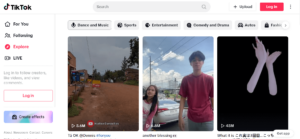
TikTok has experienced remarkable growth since its introduction in 2016, counting almost a billion users worldwide. The platform presents a unique approach to video monetization, with creators earning from the Creator Fund, a pool of funds distributed based on viewership, engagement, and policy compliance. Additionally, the Creator Marketplace offers opportunities for brand sponsorships, making it ideal for influencer marketing.
Creators receive their payment through PayPal or Zelle a month after they earn their money. Eligibility for the Creator Fund requires residence in select countries, as well as meeting certain follower and view thresholds.
Some of TikTok’s most notable monetization features include live streaming, TikTok Shopping, in-feed ads, analytics, and donations.
8. Thinkific

Thinkific is an online learning platform which offers content creators and educators attractive options to sell their online courses and share knowledge.
Thinkific provides four content monetization options:
- Third-party ads included in your content, for example product placements, PPC advertising, and affiliate marketing
- Premium content for which your audience would have to pay to access
- Content monetization platforms like Facebook or YouTube will act like a third party between you and advertisers, so if you mostly publish your content on social media platforms, this is the easiest way to start monetizing it
- Monetizing your fan base through the sales of new products like mugs and T-shirts. You may also launch a Patreon to take donations or offer exclusive content
As a course platform, it can be an appealing option to educators, although the free plan is somewhat basic, according to online reviews. Thinkific also lacks live streaming, so if you want to engage directly and in real-time with your students, you might need to search for other platforms.
9. Wistia
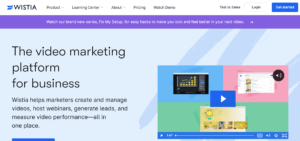
Wistia is a video hosting site which offers subscriptions, advertisement, and one-off monetization methods to help you collect revenue from a wide range of customers. As the platform offers subscription videos on demand, you can have a peace of mind that you’ll earn a consistent income.
Wistia’s page builder tools aren’t as advanced as some other tools on the market, so it might be a bit more difficult to create a Wistia channel page that looks like your website. However, looking at online reviews, people seem to praise the platform’s easy navigation and analytics.
10. Muvi
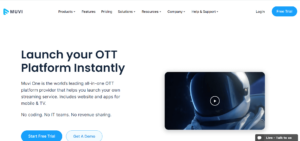
Muvi is an OTT video platform which supports both live streaming and VOD. It’s designed to support content creators in launching multi-device streaming and video streaming platforms.
With Muvi, you can showcase your videos in various formats on TV, android, or Apple devices. The OTT platform also supports broadcasting and audio streaming on demand if you want to create services like Shopify. Muvi’s paywall implementation works with all major advertising and subscription models.
It can be expensive for beginners as the standard plan costs $399 per month for 2000 concurrent users. The more you spend on the platform, the more you can expect in terms of bandwidth, storage, and support.
11. Cleeng

Cleeng is a subscriber-based video monetization platform which leverages artificial intelligence and machine learning capabilities to help you boost subscriptions. It’s not necessarily a video hosting platform but a tool you can use with a video hosting platform to monetize your content.
Cleeng’s paywall options include VOD subscriptions and pay-per-view live streaming.
Cleeng has got a range of features including detailed predictive analytics so you can improve your long-term revenue strategy. You can get an accurate idea of the pricing by visiting their website and inputting the number of managed users you have.
12. Dacast
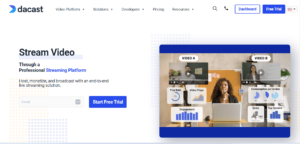
Dacast is a live streaming and VOD platform which supports all common video monetization models and facilitates global payments.
You can broadcast live or on-demand content through Dacast to your own OTT apps across all devices and benefit from a customizable video player and a range of secure and easy to use features.
According to some user reviews on Capterra, the latency can be an issue, especially when live streaming on Dacast.
Prices vary depending on bandwidth and storage, with their Starter plan costing $39 per month for 1,000 GB of bandwidth and 50 GB of storage.
How to monetize your YouTube video
Some businesses prefer to begin their video monetization journey with YouTube, since its monolithic presence makes it easy to just upload and publish.
Monetizing your YouTube videos primarily involves joining the YouTube Partner Program (YPP), granting you the opportunity to earn income through your community and ads. Under the YPP. YouTube compensates creators via Google AdSense, with revenues generated by viewer interactions with ads in videos. This income is shared, with creators receiving 55% and YouTube retaining 45%.
The eligibility requirements for reaching YPP status include 500 subscribers, three recent uploads, and either 3,000 public watch hours in the past year or 3 million YouTube Shorts views. Alternatively, you can enable monetization by reaching 1,000 subscribers and 4,000 hours of public watch time within a year. Once admitted into the YPP, creators gain access to revenue tools.
While AdSense provides a consistent revenue stream, supplementing earnings is possible through sponsorship deals, affiliate marketing, or live streams.
It’s important to highlight the difference between revenue from a channel membership and a YouTube Premium subscription. Namely, YouTube Premium subscribers don’t get ads, meaning that you make money depending on how much your audience watches your content.
On the other hand, a channel membership unlocks access to members-only perks which can boost your income as a creator. These include custom emojis, badges, Super Chats, Super Stickers, or Super Thanks.
Disadvantages of monetizing with YouTube
Starting a journey with monetizing YouTube content also brings some challenges to be aware of. Here are some key drawbacks to consider:
1. Demonetization
While it’s difficult to figure out your exact income on any monetization platform, YouTube’s demonetization policy makes it even more complicated for creators to get an accurate estimate.
While adhering to YouTube’s Community Guidelines might seem straightforward, the platform’s algorithm updates have triggered demonetization even for videos that don’t violate rules. The process of contesting these actions, although possible, tends to be unfavorable for content creators.
2. Earnings Deduction
Similar to other monetization platforms, YouTube uses a revenue-sharing model to pay its creators. Nevertheless, the platform imposes one of the industry’s highest fees. As mentioned previously, a substantial 45% of the creator’s earnings are claimed by the platform.
3. Restricted Monetization Tools
To monetize your YouTube videos, you need an Google AdSense account. However, the popular ad network has limited monetization features.
While ad podding and in-stream video ads are among YouTube’s most prominent features, the platform lacks support for multiple supply-side platforms (SSPs), necessary for real-time bidding transactions.
4. Ad Blockers
If your YouTube audience uses ad blockers to view your content, you could lose a significant portion of the advertising revenue generated through different types of ads.
How to monetize without YouTube
In a digital age dominated by video content consumption, creators have multiple avenues to monetize their videos. Interestingly, you don’t need a YouTube account to earn an income from your content. Keep reading to learn how to make money through alternative monetization methods.
1. Affiliate Marketing
Promote affiliate products or services relevant to your content through an affiliate program. By including affiliate links in your video descriptions or dedicated marketing videos, you can earn a commission on sales generated through your referral.
2. SEO
Implementing effective SEO practices in your marketing strategy can amplify the reach and impact of your video content. By optimizing your video titles, thumbnails, descriptions, and tags with relevant keywords, you can increase the chances of your videos appearing in search engines. Consider researching long-tail keywords that address specific pain points or queries within your niche. Optimizing your video’s metadata not only aids discoverability but also supports your monetization strategies.
3. Sponsored Content and Brand Partnerships
To make money online from sponsored videos, you need to establish a strong brand and audience in your niche first. Create a compelling portfolio showcasing your content quality. Then, research and approach relevant brands with personalized pitches, emphasizing the value you bring to their audience.
4. Partnering With an OTT Platform
Expanding the visibility of your video content is paramount when it comes to monetization. Establishing a collaboration with an OTT platform is an effective strategy to amplify your audience reach.
OTT technology offers viewers the flexibility to access content across a range of devices, spanning computers, mobile devices, gaming consoles, and smart TVs (Amazon Fire TV, Roku, etc.). Furthermore, OTT uses the open internet for end-to-end transmission. This means that audiences can stream premium video content with just an internet connection and a compatible device, while providers monetize their offerings.
5. Content Licensing
Licensing your videos to businesses, media outlets, or educational institutions can be profitable. Your content can be used in various contexts, including commercials, tutorials, presentations, training materials, or documentaries. Stock video platforms allow you to sell your footage to other bloggers or content creators.
6. Crowdfunding and Donations
Crowdfunding platforms allow creators to gather financial support from their audience for specific projects. By selling merchandise, exclusive content and perks, or giving personal acknowledgements, you can incentivize backers and fund your creative endeavors.
7. Blockchain and NFTs
Non-fungible tokens (NFTs) are a novel way to monetize digital content. Creators can mint NFTs representing ownership of their videos or art and sell them as digital products on NFT marketplaces.
What video content can be monetized?
Now that we’ve covered some additional money-making strategies, let’s take a look at what type of content you can monetize:
- Live events – sports matches, concerts,
- Entertainment – comedy sketches, parodies, short films, and music videos
- Educational and how-to content – tutorials, instructional videos, and online courses
- Gaming content – gameplay walkthroughs or live streams on platforms like Twitch
- Vlogs and personal content – personal blogs, daily vlogs, or lifestyle videos
- Product reviews – unboxing and review videos
- Travel and adventure content – travel vlogs and destination guides
- Fitness and wellness content – workout routines, fitness and wellness advice, guided meditation
- Cooking videos – cooking tutorials, recipe demonstrations, or culinary tips
- Fashion and beauty – makeup tutorials, fashion hauls, skincare routines, or style advice videos
- DIY and crafts – crafting tutorials and DIY projects
- Science and technology – science lessons, discussions, or tech reviews
- Motivational and self-help – motivational speeches and self-help advice
- Documentary and investigative content – in-depth documentaries, investigative journalism, and analytical videos
While we did learn that you have the freedom to capture all kinds of content on camera, it doesn’t automatically translate into the ability to monetize all of it.
Namely, streaming platforms enforce regulations, terms of service, and community guidelines to safeguard users and creators against plagiarism or harmful content. These are the most common types of content you can’t make money from:
- Explicit or adult content
- Offensive content
- Copyright-infringing content
- Misleading information and fake news
Ultimately, it’s essential to check your preferred monetization platform’s guidelines before you upload videos. Our advice is to always consider educational elements during your content creation to enhance its value and appeal.
Start monetizing your video content with JWP
Whether you’re an advertiser, influencer, fitness instructor, broadcaster or publisher, there are many video monetization options available for you. With the right platform, you can create an effective content marketing strategy, while earning a regular income from a loyal community of like-minded people who enjoy your high-quality video content.
When considering video monetization platforms, always have your audience and goals in mind to ensure you get the best for your money. Always check the company’s monetization policies, payment terms, customer support, and the difficulty of implementation to find the best fit for you.
Start maximizing your video monetization potential with JWP’s platform today!
